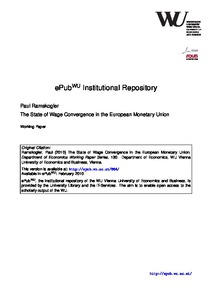The state of wage convergence in the European Monetary Union. The interdependence of European manufacturing wage growth and its limited impact on competitiveness
"Before the introduction of the Euro many observers had expected an increase of inflationary pressures due to a de-coordination-shock to national wage bargaining. However, if anything systematically happened after the introduction of the Euro wage restraint increased (Posen and Gould 2006). A p...
| Main Author: | |
|---|---|
| Institution: | ETUI-European Trade Union Institute |
| Format: | TEXT |
| Language: | English |
| Published: |
Vienna
2010
Vienna University of Economics |
| Subjects: | |
| Online Access: | https://www.labourline.org/KENTIKA-19185341124919035239-The-state-of-wage-convergence-.htm |
| Summary: | "Before the introduction of the Euro many observers had expected an increase of inflationary pressures due to a de-coordination-shock to national wage bargaining. However, if anything systematically happened after the introduction of the Euro wage restraint increased (Posen and Gould 2006). A possible explanation for this finding is that a system of pattern bargaining has emerged with Germany figuring as a "centre of gravity" for European wage bargains (Traxler et al. 2008, Traxler and Brandl 2009). This paper studies wage and nominal unit labour cost spill-overs for the EMU for a panel over 13 manufacturing sectors from 1992-2005 and quantifies the effects of different countries. It turns out that there are strong interdependencies across EMU-members with regard to nominal wage growth. Indeed, a leading role accrues to Germany whose wage developments are twice as influential as those of the next important countries. Remarkably, the strong interdependence of wage growth is not reflected with regard to unit labour costs. Here, only the development in a core group composed of Austria, France, Germany and the Netherlands, is bound to each other. The development of nominal unit labour costs in other countries is largely independent from each other and especially from this core group." |
|---|---|
| Physical Description: | 28 p. Digital |

